Abstract
We have investigated the possibility that the abnormally decreased gall bladder contraction after meals in patients with coeliac disease might result in part from an abnormality in the gall bladder response to endogenous cholecystokinetic hormones--for example, cholecystokinin and motilin--rather than solely from decreased secretion of such hormones. Eight patients with untreated coeliac disease and nine controls received intravenous infusions of the pure synthetic cholecystokinin analogue caerulein, 2-16 ng/kg/hour. Gall bladder emptying was measured on a minute-by-minute basis using 99mTc-HIDA scans. In the patients with coeliac disease, gall bladder emptying was greatly decreased (34.6 +/- 9.9 v 61.5 +/- 7.5% at 60 minutes, p less than 0.02), and a much greater dose of caerulein was needed to initiate gall bladder contraction (3.80 +/- 1.08 v 1.49 +/- 0.56 ng/kg, p less than 0.02). These results suggest that the abnormal gall bladder contraction in coeliac disease is not simply because of impaired release of cholecystokinin. Although mechanical factors secondary to the increased gall bladder size in patients with coeliac disease might to some extent account for the findings, the alternative explanation is that the gall bladder muscle is for some reason resistant to the action of cholecystokinetic agents. A similar phenomenon affecting the pancreas might contribute to the abnormally decreased pancreatic secretion found in coeliac disease.
Full text
PDF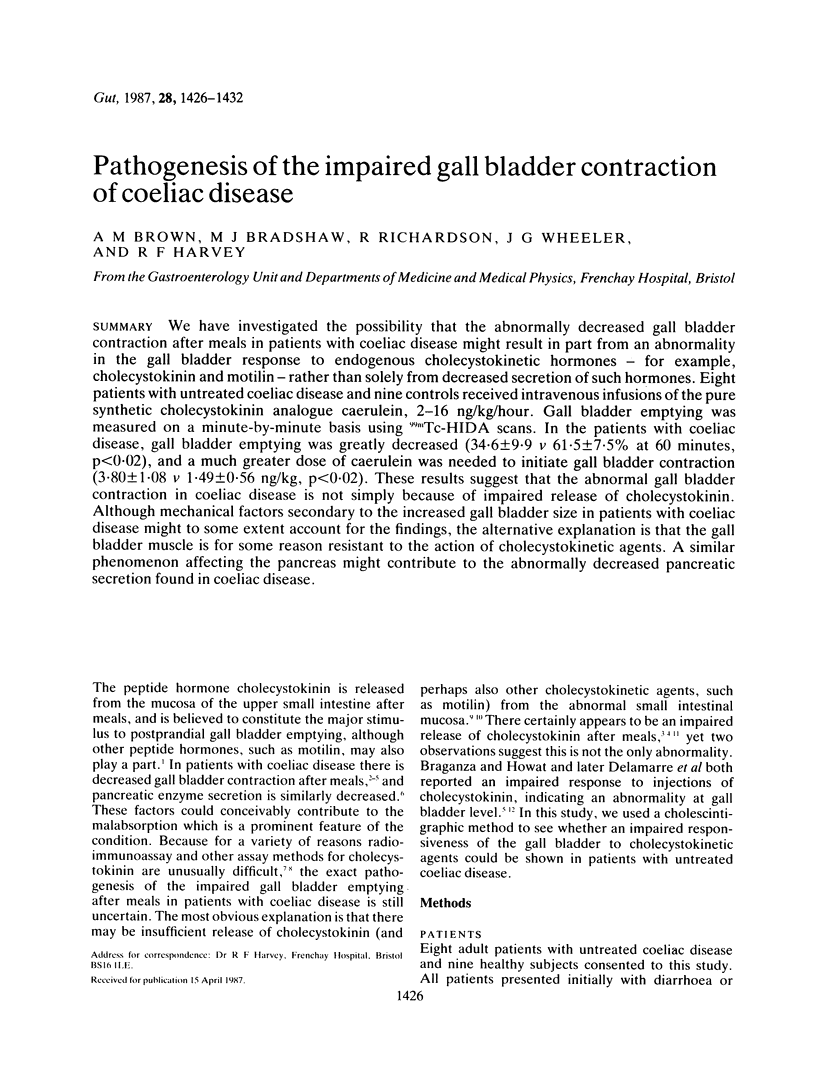
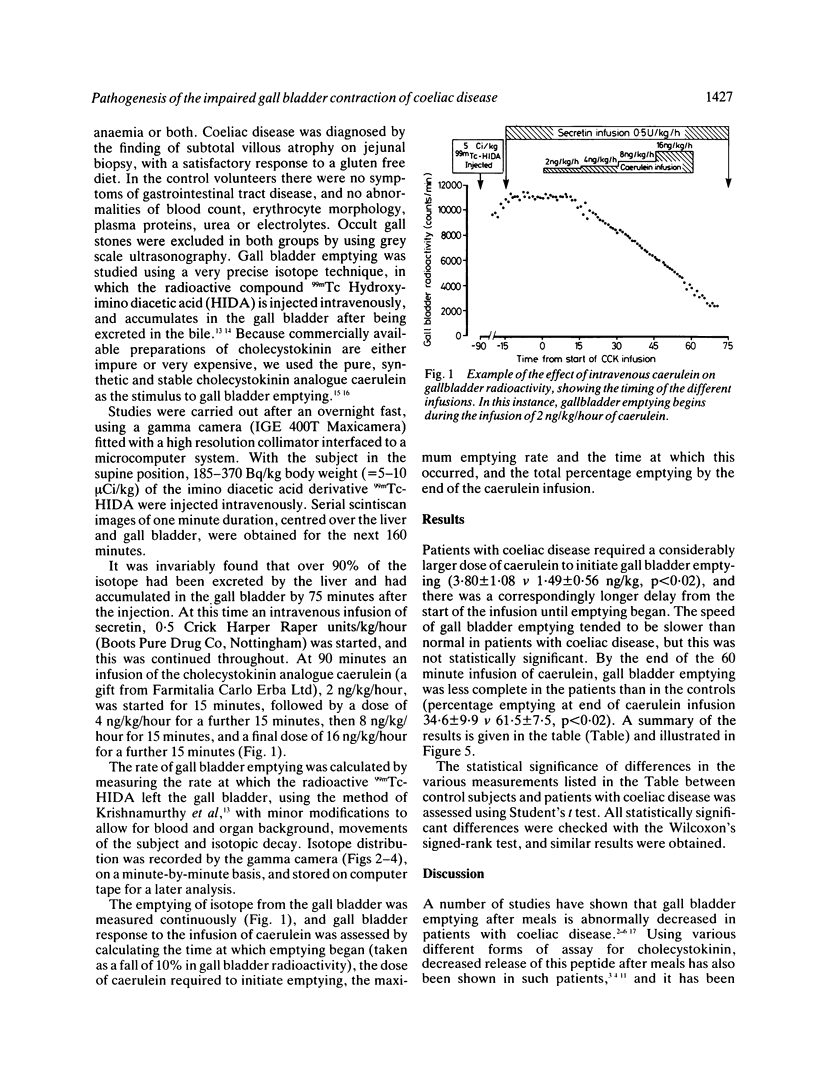
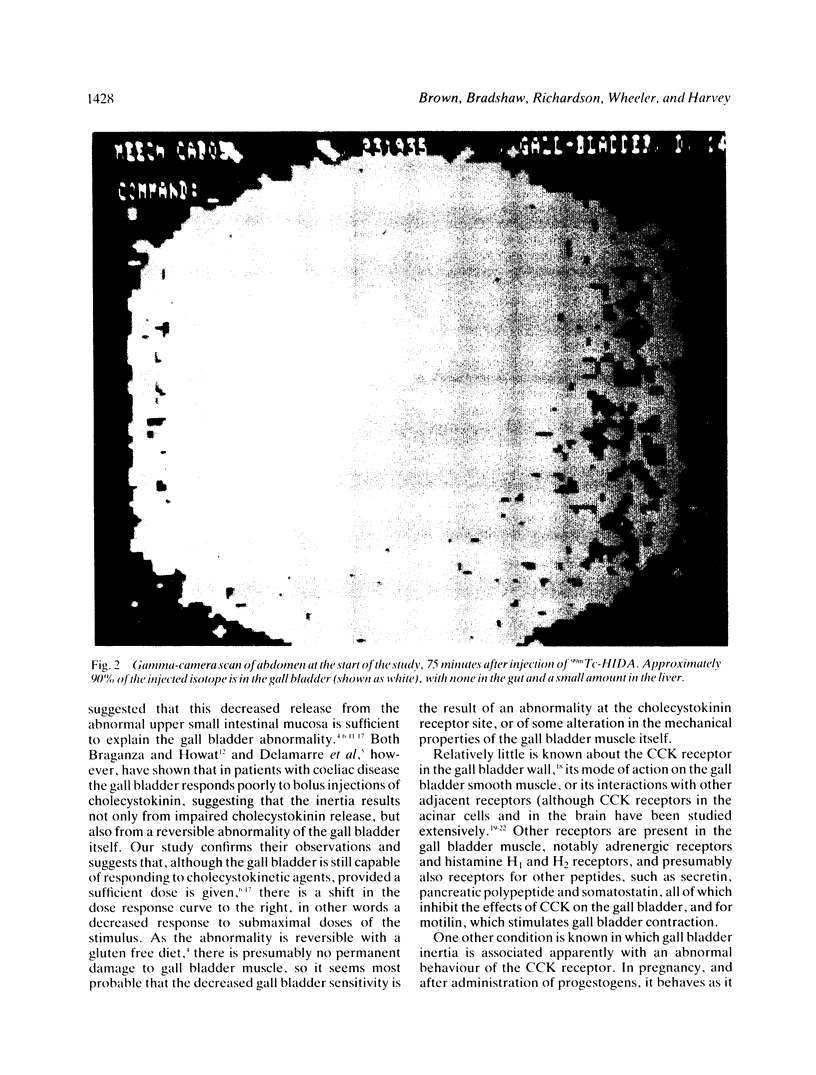
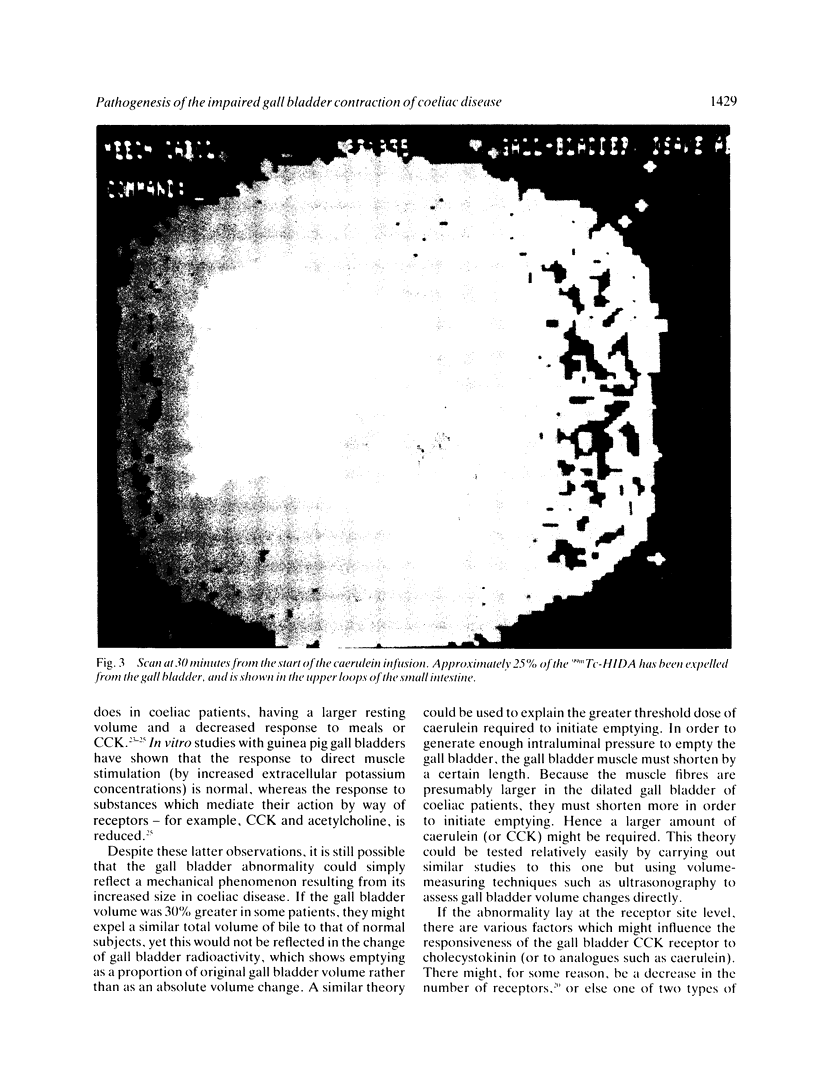
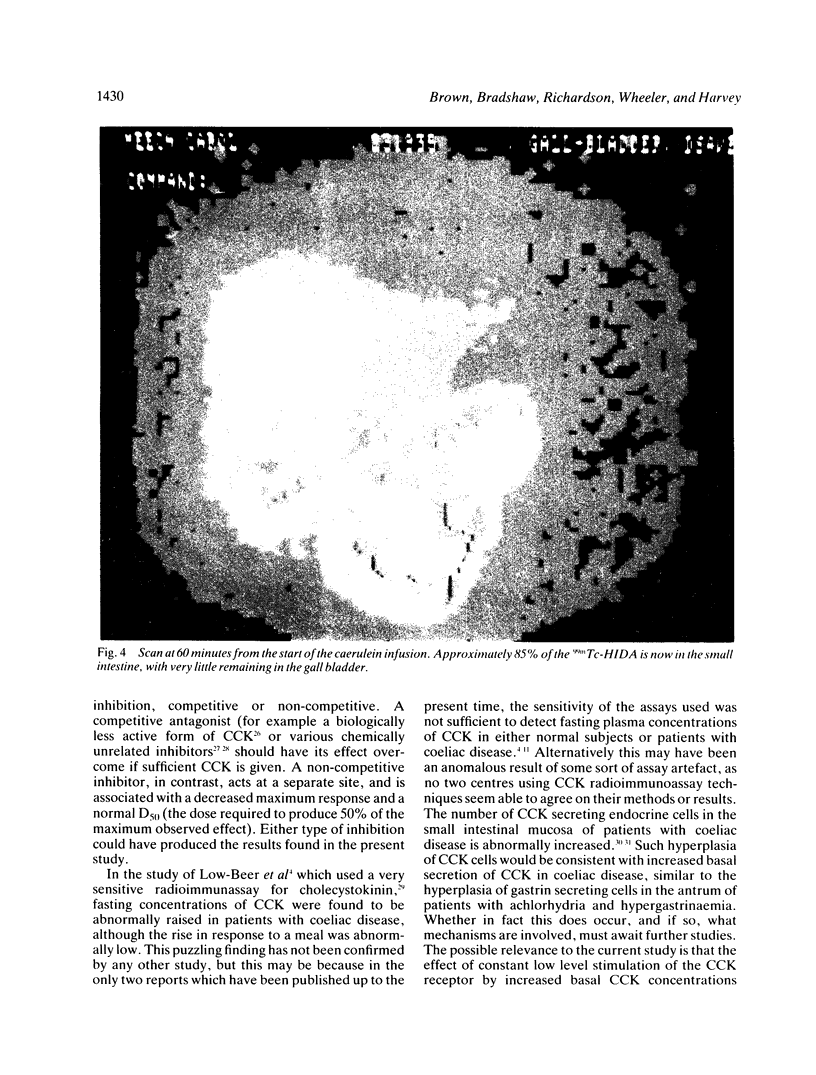
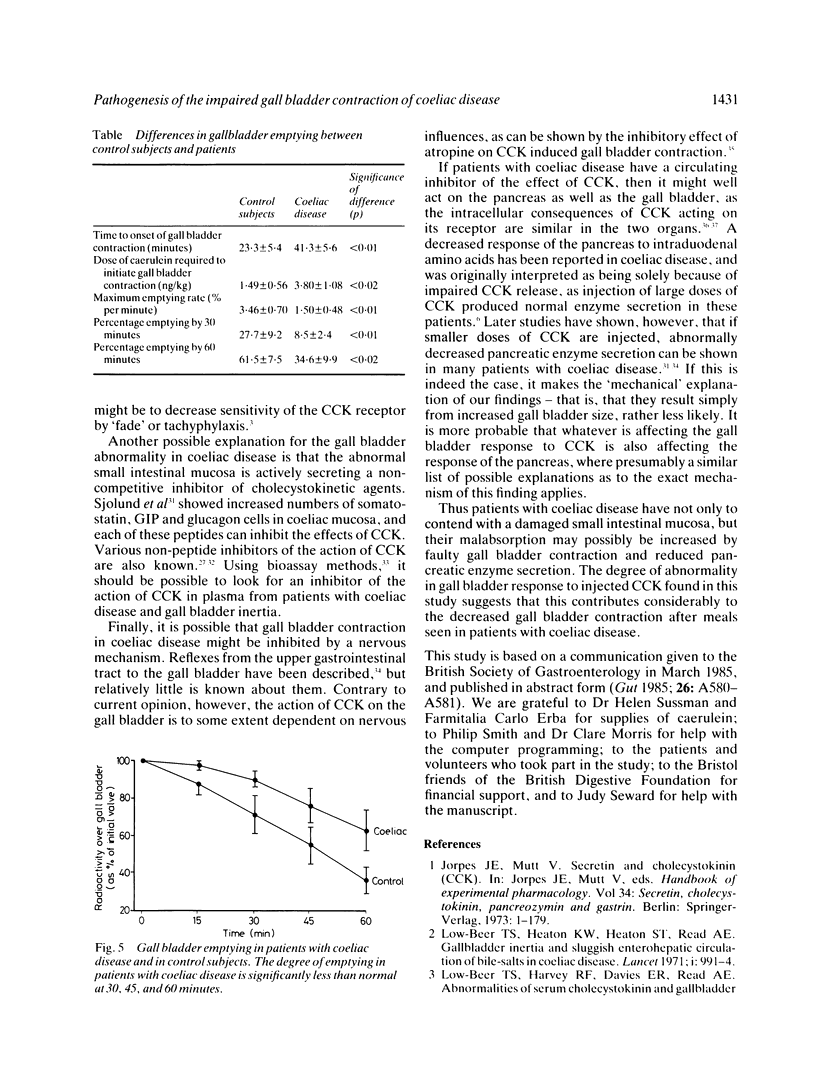
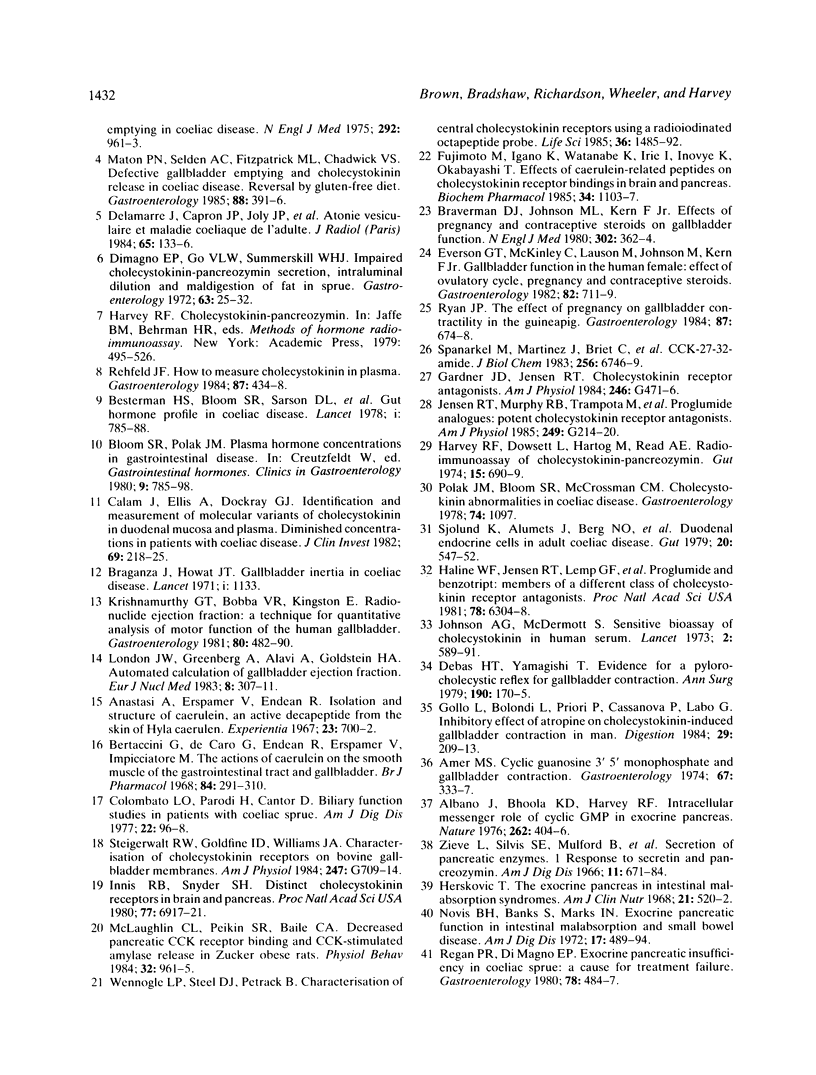
Images in this article
Selected References
These references are in PubMed. This may not be the complete list of references from this article.
- Albano J., Bhoola K. D., Harvey R. F. Intracellular messenger role of cyclic GMP in exocrine pancreas. Nature. 1976 Jul 29;262(5567):404–406. doi: 10.1038/262404a0. [DOI] [PubMed] [Google Scholar]
- Amer M. S. Cyclic guanosine 3',5'-monophosphate and gallbladder contraction. Gastroenterology. 1974 Aug;67(2):333–337. [PubMed] [Google Scholar]
- Anastasi A., Erspamer V., Endean R. Isolation and structure of caerulein, an active decapeptide from the skin of Hyla caerulea. Experientia. 1967 Sep 15;23(9):699–700. doi: 10.1007/BF02154119. [DOI] [PubMed] [Google Scholar]
- Bertaccini G., De Caro G., Endean R., Erspamer V., Impicciatore M. The actions of caerulein on the smooth muscle of the gastrointestinal tract and the gall bladder. Br J Pharmacol. 1968 Oct;34(2):291–310. doi: 10.1111/j.1476-5381.1968.tb07052.x. [DOI] [PMC free article] [PubMed] [Google Scholar]
- Besterman H. S., Bloom S. R., Sarson D. L., Blackburn A. M., Johnston D. I., Patel H. R., Stewart J. S., Modigliani R., Guerin S., Mallinson C. N. Gut-hormone profile in coeliac disease. Lancet. 1978 Apr 15;1(8068):785–788. doi: 10.1016/s0140-6736(78)92994-x. [DOI] [PubMed] [Google Scholar]
- Bloom S. R., Polak J. M. Plasma hormone concentrations in gastrointestinal disease. Clin Gastroenterol. 1980 Sep;9(3):785–798. [PubMed] [Google Scholar]
- Braganza J., Howat H. T. Rapid evaluation of creatinine clearance. Lancet. 1971 May 29;1(7709):1133–1133. doi: 10.1016/s0140-6736(71)91872-1. [DOI] [PubMed] [Google Scholar]
- Braverman D. Z., Johnson M. L., Kern F., Jr Effects of pregnancy and contraceptive steroids on gallbladder function. N Engl J Med. 1980 Feb 14;302(7):362–364. doi: 10.1056/NEJM198002143020702. [DOI] [PubMed] [Google Scholar]
- Calam J., Ellis A., Dockray G. J. Identification and measurement of molecular variants of cholecystokinin in duodenal mucosa and plasma. Diminished concentrations in patients with celiac disease. J Clin Invest. 1982 Jan;69(1):218–225. doi: 10.1172/JCI110433. [DOI] [PMC free article] [PubMed] [Google Scholar]
- Colombato L. O., Parodi H., Cantor D. Biliary function studies in patients with celiac sprue. Am J Dig Dis. 1977 Feb;22(2):96–98. doi: 10.1007/BF01072949. [DOI] [PubMed] [Google Scholar]
- Debas H. T., Yamagishi T. Evidence for a pyloro-cholecystic reflex for gallbladder contraction. Ann Surg. 1979 Aug;190(2):170–175. doi: 10.1097/00000658-197908000-00008. [DOI] [PMC free article] [PubMed] [Google Scholar]
- Delamarre J., Capron J. P., Joly J. P., Rémond A., Audebert M., Murat J. L., Revert R., Trinez G. Atonie vésiculaire et maladie coeliaque de l'adulte. Etude radiographique et échographique de 15 cas. J Radiol. 1984 Mar;65(3):133–136. [PubMed] [Google Scholar]
- DiMagno E. P., Go W. L., Summerskill W. H. Impaired cholecystokinin-pancreozymin secretion, intraluminal dilution, and maldigestion of fat in sprue. Gastroenterology. 1972 Jul;63(1):25–32. [PubMed] [Google Scholar]
- Everson G. T., McKinley C., Lawson M., Johnson M., Kern F., Jr Gallbladder function in the human female: effect of the ovulatory cycle, pregnancy, and contraceptive steroids. Gastroenterology. 1982 Apr;82(4):711–719. [PubMed] [Google Scholar]
- Fujimoto M., Igano K., Watanabe K., Irie I., Inouye K., Okabayashi T. Effects of caerulein-related peptides on cholecystokinin receptor bindings in brain and pancreas. Biochem Pharmacol. 1985 Apr 1;34(7):1103–1107. doi: 10.1016/0006-2952(85)90616-1. [DOI] [PubMed] [Google Scholar]
- Gardner J. D., Jensen R. T. Cholecystokinin receptor antagonists. Am J Physiol. 1984 May;246(5 Pt 1):G471–G476. doi: 10.1152/ajpgi.1984.246.5.G471. [DOI] [PubMed] [Google Scholar]
- Gullo L., Bolondi L., Priori P., Casanova P., Labò G. Inhibitory effect of atropine on cholecystokinin-induced gallbladder contraction in man. Digestion. 1984;29(4):209–213. doi: 10.1159/000199035. [DOI] [PubMed] [Google Scholar]
- Hahne W. F., Jensen R. T., Lemp G. F., Gardner J. D. Proglumide and benzotript: members of a different class of cholecystokinin receptor antagonists. Proc Natl Acad Sci U S A. 1981 Oct;78(10):6304–6308. doi: 10.1073/pnas.78.10.6304. [DOI] [PMC free article] [PubMed] [Google Scholar]
- Harvey R. F., Dowsett L., Hartog M., Read A. E. Radioimmunoassay of cholecystokinin-pancreozymin. Gut. 1974 Sep;15(9):690–699. doi: 10.1136/gut.15.9.690. [DOI] [PMC free article] [PubMed] [Google Scholar]
- Herskovic T. The exocrine pancreas in intestinal malabsorption syndromes. Am J Clin Nutr. 1968 May;21(5):520–522. doi: 10.1093/ajcn/21.5.520. [DOI] [PubMed] [Google Scholar]
- Innis R. B., Snyder S. H. Distinct cholecystokinin receptors in brain and pancreas. Proc Natl Acad Sci U S A. 1980 Nov;77(11):6917–6921. doi: 10.1073/pnas.77.11.6917. [DOI] [PMC free article] [PubMed] [Google Scholar]
- Jensen R. T., Murphy R. B., Trampota M., Schneider L. H., Jones S. W., Howard J. M., Gardner J. D. Proglumide analogues: potent cholecystokinin receptor antagonists. Am J Physiol. 1985 Aug;249(2 Pt 1):G214–G220. doi: 10.1152/ajpgi.1985.249.2.G214. [DOI] [PubMed] [Google Scholar]
- Johnson A. G., McDermott S. J. Sensitive bioassay of cholecystokinin in human serum. Lancet. 1973 Sep 15;2(7829):589–591. doi: 10.1016/s0140-6736(73)92416-1. [DOI] [PubMed] [Google Scholar]
- Krishnamurthy G. T., Bobba V. R., Kingston E. Radionuclide ejection fraction: a technique for quantitative analysis of motor function of the human gallbladder. Gastroenterology. 1981 Mar;80(3):482–490. [PubMed] [Google Scholar]
- London J. W., Greenberg A., Alavi A., Goldstein H. A. Automated calculation of gallbladder ejection fraction. Eur J Nucl Med. 1983;8(7):307–311. doi: 10.1007/BF00253757. [DOI] [PubMed] [Google Scholar]
- Low-Beer T. S., Harvey R. F., Davies E. R., Read A. F. Abnormalities of serum cholecystokinin and gallbladder emptying in celiac disease. N Engl J Med. 1975 May 1;292(18):961–963. doi: 10.1056/NEJM197505012921807. [DOI] [PubMed] [Google Scholar]
- Low-Beer T. S., Heaton K. W., Heaton S. T., Read A. E. Gallbladder inertia and sluggish enterohepatic circulation of bile-salts in coeliac disease. Lancet. 1971 May 15;1(7707):991–994. doi: 10.1016/s0140-6736(71)91387-0. [DOI] [PubMed] [Google Scholar]
- Maton P. N., Selden A. C., Fitzpatrick M. L., Chadwick V. S. Defective gallbladder emptying and cholecystokinin release in celiac disease. Reversal by gluten-free diet. Gastroenterology. 1985 Feb;88(2):391–396. doi: 10.1016/0016-5085(85)90497-4. [DOI] [PubMed] [Google Scholar]
- McLaughlin C. L., Peikin S. R., Baile C. A. Decreased pancreatic CCK receptor binding and CCK-stimulated amylase release in Zucker obese rats. Physiol Behav. 1984 Jun;32(6):961–965. doi: 10.1016/0031-9384(84)90286-5. [DOI] [PubMed] [Google Scholar]
- Novis B. H., Bank S., Marks I. N. Exocrine pancreatic function in intestinal malabsorption and small bowel disease. Am J Dig Dis. 1972 Jun;17(6):489–494. doi: 10.1007/BF02231203. [DOI] [PubMed] [Google Scholar]
- Regan P. T., DiMagno E. P. Exocrine pancreatic insufficiency in celiac sprue: a cause of treatment failure. Gastroenterology. 1980 Mar;78(3):484–487. [PubMed] [Google Scholar]
- Rehfeld J. F. How to measure cholecystokinin in plasma? Gastroenterology. 1984 Aug;87(2):434–438. [PubMed] [Google Scholar]
- Ryan J. P. Effect of pregnancy on gallbladder contractility in the guinea pig. Gastroenterology. 1984 Sep;87(3):674–678. [PubMed] [Google Scholar]
- Sjölund K., Alumets J., Berg N. O., Håkanson R., Sundler F. Duodenal endocrine cells in adult coeliac disease. Gut. 1979 Jul;20(7):547–552. doi: 10.1136/gut.20.7.547. [DOI] [PMC free article] [PubMed] [Google Scholar]
- Spanarkel M., Martinez J., Briet C., Jensen R. T., Gardner J. D. Cholecystokinin-27-32-amide. A member of a new class of cholecystokinin receptor antagonists. J Biol Chem. 1983 Jun 10;258(11):6746–6749. [PubMed] [Google Scholar]
- Steigerwalt R. W., Goldfine I. D., Williams J. A. Characterization of cholecystokinin receptors on bovine gallbladder membranes. Am J Physiol. 1984 Dec;247(6 Pt 1):G709–G714. doi: 10.1152/ajpgi.1984.247.6.G709. [DOI] [PubMed] [Google Scholar]
- Wennogle L. P., Steel D. J., Petrack B. Characterization of central cholecystokinin receptors using a radioiodinated octapeptide probe. Life Sci. 1985 Apr 15;36(15):1485–1492. doi: 10.1016/0024-3205(85)90057-8. [DOI] [PubMed] [Google Scholar]
- Zieve L., Silvis S. E., Mulford B., Blackwood W. D. Secretion of pancreatic enzymes. I. Response to secretin and pancreozymin. Am J Dig Dis. 1966 Sep;11(9):671–684. doi: 10.1007/BF02239420. [DOI] [PubMed] [Google Scholar]





